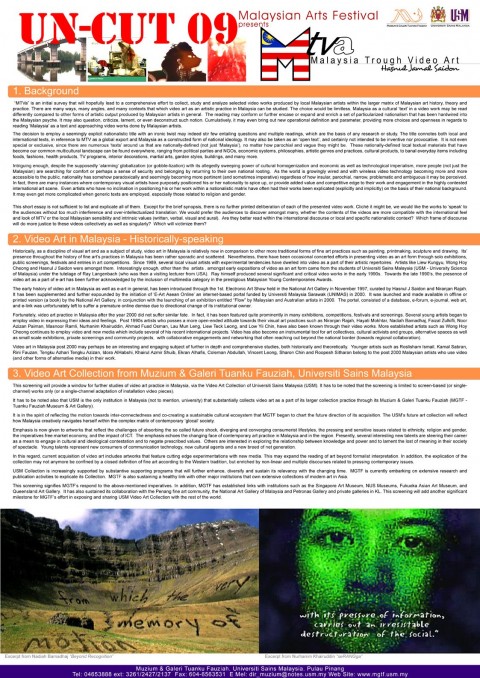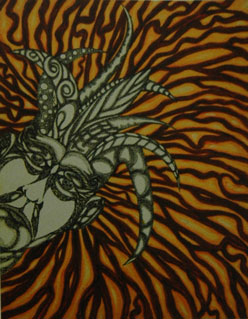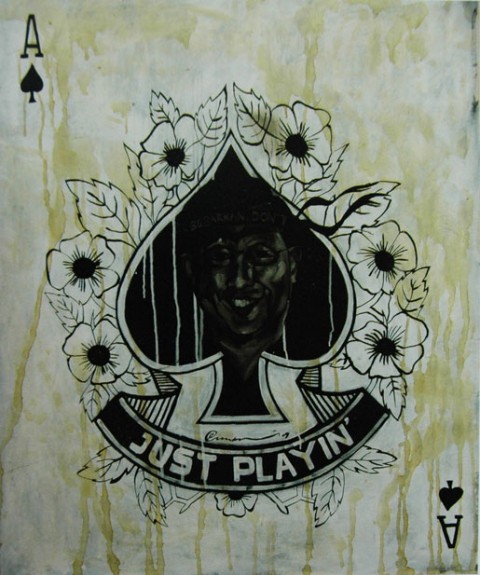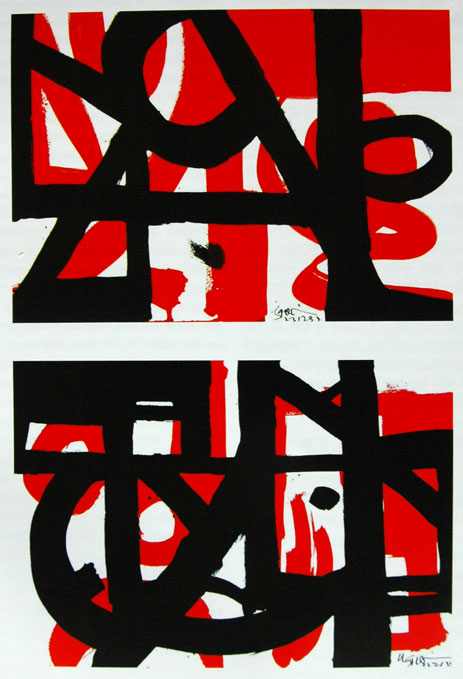

I know only a couple of things about Denmark: Danish pastries (yummy), Great Danes (dogs as big as little cows) and the infamous cartoons of Prophet Muhammad that sparked furious debate about religious tolerance, cultural representation and freedom of speech way back in 2005.
So I was fascinated to hear about UNCUT09, the first ever Malaysian Arts Festival held in the Scandinavian world. The ambitious project belongs to Amir Zainorin, a Malaysian artist based in Copenhagen, who initiated the festival through his newly established collective JAMBATAN. Running from 5 – 15 August 2009, the programme included forums, workshops, dance performances, screenings and an art exhibition, UNCUT: Malaysian Paintings, curated by Nur Hanim Khairuddin.
Projects like these are no small feat. Logistically, it goes without saying. But equally difficult to navigate is the idea of presenting a slice of Malaysia to audiences who may not know much about us. The contents of UNCUT09 may seem a little random, but increasingly, I think programmes that avoid grand narratives more accurately reflect who we are and where we are now as a country.
Below, Amir and Nur Hanim say more about UNCUT09 in an interview conducted over email.
More info on UNCUT09 by clicking:


Flyers for the video art screening programme, from the collection of USM – probably the only public institution progressive enough to acquire Malaysian video works. Click to enlarge.
(SC)
Sharon Chin: I’m interested in the title UNCUT for this Malaysian Arts Festival. I know one of the reasons why it was chosen is because phonetically it sounds like ‘ANGKAT’, which means lift or promote in Bahasa Malaysia. Does ‘Un-cut’ also mean un-censored? What do you think was left un-cut in this festival? Pada masa yang sama, apakah yang cuba diangkat? [At the same time, what has been lifted or promoted?]
Amir Zainorin: Ahh……everything that was shown in this festival was left uncut. All the artworks sent for the exhibition were exhibited at the gallery and all the artists-performers were free to do their show.
But due to some technical problems with the DVDs sent from USM, some of the films couldn’t be screened at the Museum of Contemporary Art Roskilde.
Nur Hanim Khairuddin: Of the few segments of the festival I can probably only answer on the art exhibition. The selection of artists was not based on any specific theme to anchor their different ideas, styles etc. We just let them submit works that they want to share on an international platform. However, I can’t deny the fact that they were chosen, first and foremost, because of certain ‘uncut’ personal and aesthetic merits that seem aligned to my curatorial scheme. Most of them have not been properly ‘exposed’ in the art scene thus far. Yet some of their artworks are significant enough for international exposure. The show was organized not so much to ‘uncut’ or ‘un-censor’, to ‘lift’ or ‘promote’ some ideas, but essentially to give a chance to these selected artists to ‘play’ at an international level.

Avroco Nasir, Larat Pagi (2009), Oil on canvas, 100 x 120cm
Sharon Chin: Now that the festival has just concluded (it was from 5 – 15 August 2009), what do you think is the idea of Malaysia that has been presented to the people of Denmark? And what has been the reaction to these ideas?
Amir Zainorin: The festival has just ended but the art exhibition is extended to 5 September 2009. I think it is very refreshing that the idea of Malaysia being is presented to the people of Denmark. You cannot really find much news on Malaysia in the Danish media and there are only over 100 Malaysians that live here. We are quite a rare species in Denmark.
All the venues involved in this festival have asked and shown interest about working on the next festival. So the reactions have been very positive.
Nur Hanim Khairuddin: I do not know the Danish audience’s response to the festival. However, through the performances, video screenings and art exposition, I hope they managed to glimpse at and henceforth grasp at least part of Malaysia’s social, political, and cultural nuances. Those nuances, albeit selected and presented randomly, perhaps in some small ways encapsulate the ‘ideas of Malaysia’.

Rahmat Haron, Untitled 2 (2009), Ink on paper, 23 x 29cm
Sharon Chin: Just to be naughty, I’m going to refer the old controversy regarding the Danish cartoons of Prophet Muhammad (Peace be Upon Him) that caused such an uproar in the Islamic world (Malaysia included) because they were perceived to be insulting. Amir, were you in Denmark at the time? What were your feelings about the matter and did it any way influence your desire to organize this arts festival?
Amir Zainorin: Yes, I was in Denmark when the whole thing erupted. The news about the cartoons were 24 hours a day in all the Danish media, so it is very difficult not to be influenced or affected by it. There were peaceful demonstrations in different cities in Denmark on the issue but there was no burning of Danish flags or things like that.
I felt I had to do something but I didn’t think of doing this art festival, it never occurred in my mind during that time.
What I did was I started to write my feelings and thoughts about what was happening to the local newspaper. I felt that both the Imams and the newpapers were neither right nor wrong. Both parties didn’t have much respect for one another and didn’t give much room for tolerance either. The Imams didn’t want to understand the Danish culture and some of them in my opinion were doing it for their own personal agendas. The newspapers, on the other hand, besides wanting to sell their papers and fighting for press freedom, didn’t understand what Muhammad really means to the Muslims.
But what comes out of this is that it makes people more aware about Islam and there has been endless dialog about the Muslim world and immigrants. Denmark has some of the strictest laws in the world on migration.
Nur Hanim Khairuddin: Amir arranged for me some interview sessions with diasporic artists and cultural activists during my trip to Copenhagen last year. This issue was also discussed during our encounter. The outcome of these intensive discussions later urged both of us to think of something that could become a vehicle promoting the cultures and arts of Malaysia, a Muslim-majority country. This vehicle or platform, however, is not at all intended as a counterpoint to the controversy. Through this exhibition we want to introduce some samples of modern, contemporary Malaysian art of painting to Danish audiences. By virtue of its presentation of the aesthetics or artistic practices fairly familiar to most viewers there, this show will act as a neutral zone that can make everyone comfortable with each other.

Jeri Azhari, Studies for KRET Series (2001), Acrylic & collage on record covers, 31 x 31cm
Sharon Chin: The festival includes workshops, performances and video screenings in addition to an exhibition. Where do you think the exhibition sits in relation to the other programs? With visual works situated firmly in the Malaysian local context, was it difficult for Danish audiences to gain understanding or access points?
Amir Zainorin: The exhibition is situated right in the walking street in Copenhagen, so people have easy access to the gallery compared to the other venues. Even though the visual works are situated firmly in the Malaysian context, the Danish audience in my opinion doesn’t have so much difficulty gaining understanding or access points. You have works like Rahmat’s which deals with capitalism, Meor’s work which addresses the environment, Jeri’s work which is associated with the mass media, Zul’s work on sexuality, Fathul’s works which are very similar to the group Cobra, etc. So even though the contexts are Malaysian, the issues addressed are international and can be associated with by people from all over the world.
Nur Hanim Khairuddin: At the outset when we designed the festival, we did not try to link up its different parts. Thematically, stylistically and content-wise, each was conceived independently. When we chose art works and video works or when we decided what sort of performances to be slotted in, we were not actually dictated by any deliberation other than our intention to highlight some random nuances of Malaysian arts, preferably the ones hitherto less exposed locally, regionally, internationally. Despite entirely being derived from the local context, I guess Danish audiences managed to catch the ‘essence’ of the narratives depicted in the paintings and videos.

Ruzekki Harris, The Ace of Spade (Just Playin’ Cards) (2009), Mixed media on canvas, 80 x 100cm
Sharon Chin: On a personal note, in what ways has this festival been significant for you both? Amir, you head a collective called ‘Jambatan’ [meaning ‘Bridge’]. Apakah hubungan anda dengan lokasi, habitat, dan pada sudut agak bertentangan, diaspora? Sejauh manakah teknologi masa kini telah mempengaruhi pemahaman kita tentang maksudnya ‘rapat’ dan ‘jauh’? [What’s your relationship to concepts of location, habitat and at the other end of the spectrum, the diasporic experience? To what extent has today’s technology affected our understanding of the meaning of ‘near’ and ‘far’?]
Amir Zainorin: One night I was working on my computer and sending an email to Nur Hanim. I got my email replied immediately by her who happened to be working very late at night. It was about 9 or 10pm in Copenhagen and must be around 3 or 4am in Malaysia. I asked Hanim, what keeps her awake working through the night to something that doesn’t promise any monetary returns? And she said ‘ it is simply the passion.’
Jambatan was born mainly because of the festival. I was approached by the World Culture Center in Copenhagen to make a Malaysian Cultural festival early last year. When we started to get things goings early this year, we found out that it is much easier to get sponsorship if you came with a body or an association. So then my wife Pia and I decided to form Jambatan.
I have been living in many different places since I was a child, so my relationship to concepts of location, habitat is increasingly becoming richer as I grow older. I grew up in different places in Malaysia,… Johor, Kelantan and Melaka. And then I went to study in Ipoh for a couple of years and was in the USA for nearly 5 years. Then I started working in KL from 1991- 1998 before I made the move to stay in Perhentian Island on the east coast of Malaysia. I came back to stay in KL in 2000 and left to live in Copenhagen in 2002.
So in a way I always had to deal with my new surroundings and trying to adapt with my new environment. The question of identity has been central to my work.
Technology has made it easier for us to be in contact with each other and it has made the world much smaller and the distance nearer. One day spent in Copenhagen might be the same in Malaysia if we don’t get out of the house but still, I miss being physically out there. There is nothing like experiencing the place on the spot. The people, food, weather, energy are all different. One is not necessarily better than the other. Remember that saying, ‘so near, yet so far’.
Being a migrant artist, I face different challenges than the local artists. Some of the challenges would be finding the right places to go to exhibit or looking for sponsorship. Another example is the language problem. Danish language is one of the most difficult, especially with the pronunciations. Even though almost everyone here speaks English, they still prefer to speak Danish to you, and if you don’t, then you will be an outsider. So I had to deal with all these prejudices, in which people look at your background rather than your artistic contribution.
Nur Hanim Khairuddin: This festival has been rather significant for me because perhaps it is the first such occasion organized to bring Malaysian art and culture to Denmark, as far as I know. Looking at the response during the opening and the fact that the show has been extended for another 3 weeks, I strongly feel the Danish audience appreciate our Malaysian art.

Samsuddin Wahab, Self Portrait as the Patriot (2009), Linocut, 110 x 79cm
Sharon Chin: And what about the next Malaysian Arts Festival in Denmark? What’s in the future? What have you learned from this festival that you’ll apply in the next one?
Amir Zainorin: The next Malaysian Arts Festival in Denmark will perhaps be in a couple of years time. It has been a great experience organizing the festival and I can see that it can only get better.
More money or sponsorship would be nice to be applied in the next festival.
Nur Hanim Khairuddin: Amir definitely needs more ‘tiang’ to support his JAMBATAN in order to carry out similar programs in the future. To have deep passion for this sort of endeavour is great; but to receive more financial funding is vital especially to cater for logistics and contingencies. The NAG and MGTF have been very much helpful with the visual art segment of this festival. ASWARA, DBP, Kraftangan or other cultural institutions should be roped in the next time. They can participate in perfomance and workshop programs which then can reduce some of Amir’s burden. It is also a good plan to create an art exchange program, so that we can bring over some Danish works and artists to Malaysia in the near future. The art exchange program will enhance cultural and artistic interaction (thus hopefully social-political understandings between the Danish and Malaysian people).


A. Samad Said, Penguncup Bahasa 1-4 (2009), Ink on paper, 42 x 59cm each
Sorry, the comment form is closed at this time.
Utusan paper got stuck in the ear. 8D
Ace= Blacks
Faded Yellow Paint Splatter = Urine / Male discharge
Just Playin = PISSING ON BLACKS IS JUST INNOCENT FUN / F**KIN WITH BLACKS IS FUN
Did Arteri feature that work as provocation @_@?
I’m so happy the splatter effect is being put to use in so many ways by Malaysian artists. Perhaps this ‘ejeculation’ mark is so popular in Malaysia because things are so often repressed in our culture, or that we are rather pissed off as a nation.